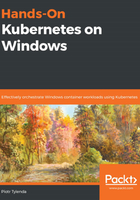
etcd cluster
To persist the cluster state, Kubernetes uses etcd – a distributed, reliable key-value store that utilizes the Raft distributed consensus algorithm in order to provide sequential consistency. The etcd cluster is the most important part of the control plane – this is the source of truth for the whole cluster, both for the current state and the desired state of the cluster.
Generally, single-node etcd clusters are only recommended for testing purposes. For production scenarios, you should always consider running at least a five-member cluster (with an odd number of members) in order to provide sufficient fault tolerance.
The watch protocol that's exposed by etcd is also a core functionality for the watch API in Kubernetes, which is provided by kube-apiserver for other components.